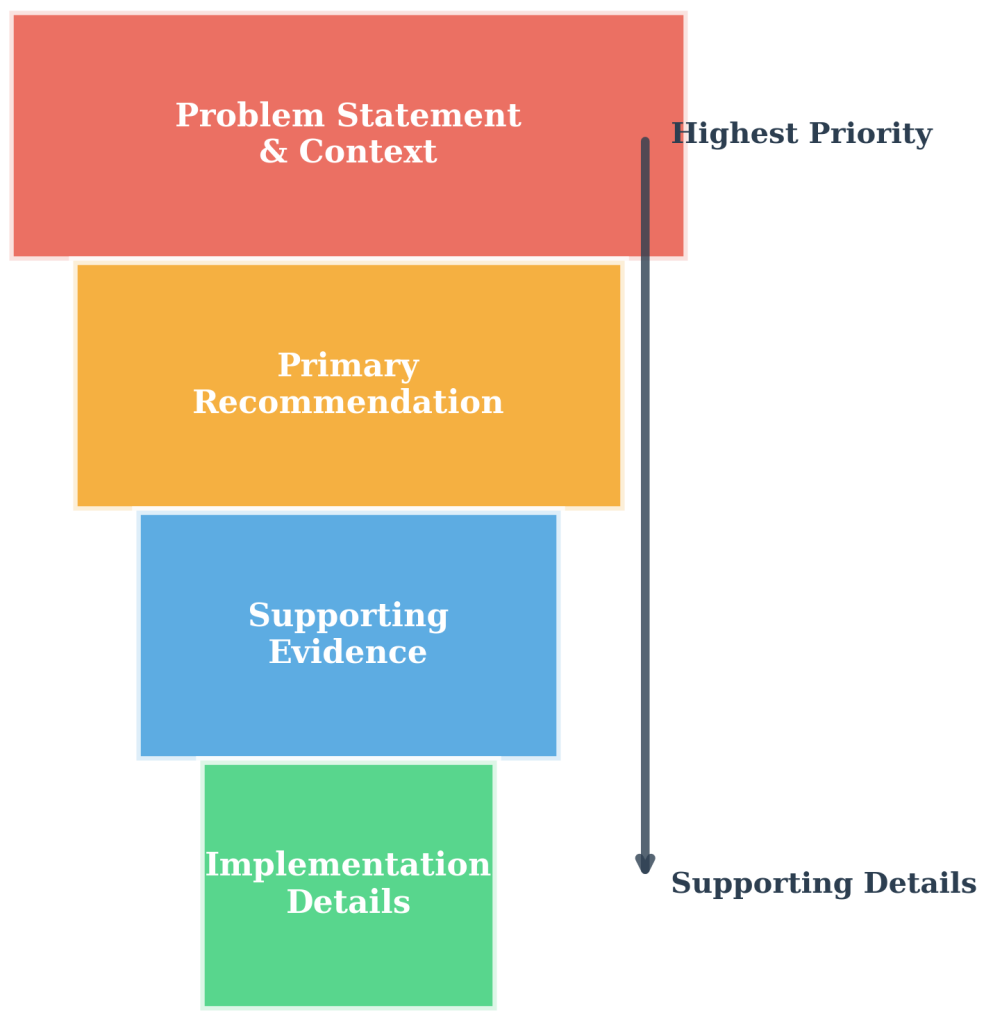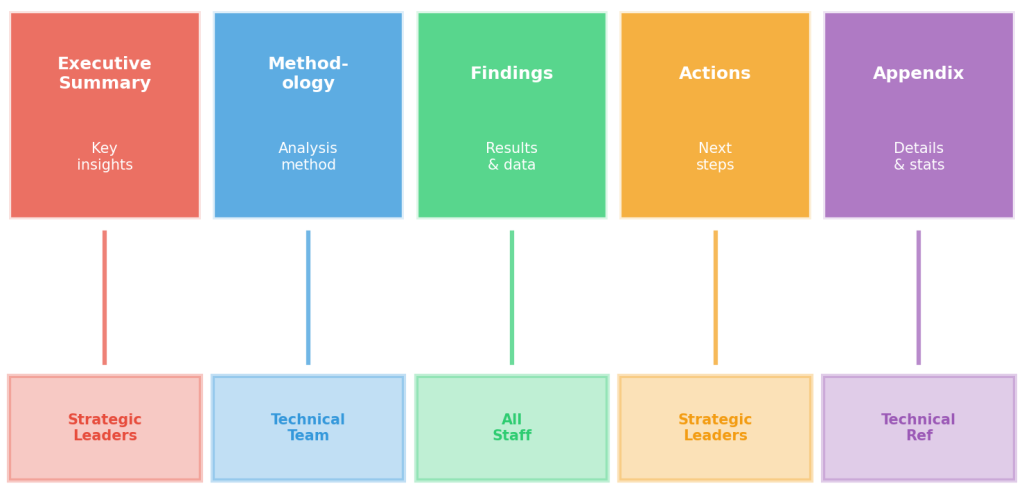Chapter 8.2: Executive Summary and Report Construction
This chapter examines the systematic construction of executive summaries and professional reports that transform analytical findings into strategic organizational decision-making tools. Key concepts include the inverted pyramid structure for prioritizing information, evidence integration techniques that support recommendations without overwhelming stakeholders, and action-oriented frameworks that connect data insights to business outcomes.
Foundations of Executive Communication
Executive summaries serve as critical communication bridges between comprehensive analytical work and strategic organizational decision-making. Unlike technical reports that detail methodology and statistical procedures, executive summaries prioritize business implications and actionable insights that enable stakeholder decisions. The most influential executive summaries follow structured frameworks that lead with recommendations, support those recommendations with targeted evidence, and conclude with specific implementation steps.
The effectiveness of executive communication lies in its ability to transform complex analytical findings into accessible decision-making information. This transformation requires systematic understanding of stakeholder information needs, organizational decision-making processes, and the specific business context within which analytical insights must generate value. Professional data science communication demands balancing comprehensive analysis with accessible presentation formats.
Executive Summary Framework: A structured approach to presenting analytical findings that prioritizes business implications, supports recommendations with targeted evidence, and enables stakeholder decision-making through clear action specifications.
The Inverted Pyramid Structure
The inverted pyramid approach places the most critical information first, recognizing that executive audiences often have limited time and need immediate access to key insights. This structure begins with a concise problem statement that establishes context, followed by the primary recommendation that addresses that problem, then supporting evidence that justifies the recommendation, and finally implementation steps that enable action. Each section serves a specific decision-making function, ensuring that stakeholders can understand the situation, evaluate the proposed solution, and authorize necessary resources.

Figure 8.2.1: The inverted pyramid structure for executive summaries prioritizes critical information by placing business problems and recommendations first, followed by supporting evidence and implementation details. This approach enables stakeholders to quickly assess decision requirements and authorization needs while providing sufficient detail for evaluation purposes.
Information hierarchy within the inverted pyramid reflects actual executive decision-making processes, where strategic implications receive immediate attention while operational details support implementation planning. The problem statement establishes business context and urgency, the primary recommendation presents the proposed solution with clear value proposition, supporting evidence provides analytical foundation for the recommendation, and implementation steps specify resource requirements and timeline expectations.
Excel Executive Dashboard Integration: Excel’s dynamic summary capabilities support inverted pyramid structure through automated key performance indicator updates, conditional formatting that highlights critical metrics, and Sparklines features that illustrate trends within executive summaries without requiring separate charts or complex visualizations that might distract from strategic focus.
Professional Report Architecture
Professional data science reports require systematic organization that includes an executive summary for strategic stakeholders, methodology section for technical audiences, findings section with supporting visualizations, and recommendations section with implementation guidance. This structure ensures that different audiences can access appropriate levels of detail while maintaining analytical credibility across all sections.
The standard framework begins with an executive summary that serves strategic decision-makers, followed by a methodology section that establishes analytical credibility for technical stakeholders. The findings section presents evidence systematically with supporting visualizations that enhance understanding without overwhelming non-technical audiences. The recommendations section connects analytical insights to specific business actions, while appendices contain detailed statistical outputs for stakeholders requiring comprehensive technical documentation.

Figure 8.2.2: Professional report structure accommodates multiple audience needs through systematic section organization. Executive summary serves strategic decision-makers requiring immediate insights, methodology sections provide technical credibility for analytical stakeholders, findings sections integrate evidence with interpretive guidance, recommendations sections specify implementation requirements, and appendices contain detailed documentation for comprehensive reference needs.
Evidence Integration and Progressive Disclosure
Evidence integration within professional reports demands careful selection of supporting materials that strengthen key arguments without overwhelming readers with excessive detail. Each piece of evidence should directly support a specific claim or recommendation, with clear connections established through transitional language and logical sequencing. The key to managing evidence complexity lies in progressive disclosure, where executive sections present high-level insights while appendices contain detailed statistical results for stakeholders requiring additional technical information.
This approach respects different audience needs while maintaining comprehensive documentation that supports organizational decision-making and future reference requirements. Statistical outputs can be formatted for professional presentation by focusing on interpretation rather than procedural details, emphasizing practical significance alongside statistical significance.
JASP Statistical Integration: JASP statistical outputs can be formatted for professional presentation by emphasizing interpretation rather than procedural details. Executive sections focus on practical significance and business implications, while technical appendices contain complete statistical procedures and detailed results for stakeholders requiring comprehensive analytical documentation.
Case Study: Spotify’s Data Science Personas Project
Spotify’s Analytics Platform team exemplifies effective executive communication through their October 2024 data science personas research project. Facing unclear user definitions that impacted product development effectiveness, the team conducted 47 structured interviews across 12 departments combined with quantitative analysis of 156,000 user sessions over 18 months. Their research identified five distinct user personas with specific tool preferences and workflow patterns.
The project’s communication strategy included tailored recommendation presentations for different stakeholder groups, development of daily classification datasets for tracking implementation progress, and collaboration with design teams to create memorable visual representations of each persona. This comprehensive approach resulted in adoption by 23 different teams across Spotify’s organization, demonstrating systematic executive communication driving widespread organizational change.
Quantifiable outcomes included 34% higher user satisfaction scores, 28% increase in daily active users, and $1.2M in development cost savings within six months of implementation. The success demonstrates how structured executive communication transforms analytical insights into measurable organizational impact through systematic stakeholder engagement and implementation tracking.
Action-Oriented Recommendation Development
Recommendations that drive organizational action must connect analytical insights directly to specific business decisions requiring stakeholder approval or resource allocation. Generic recommendations lack the specificity needed for implementation, while actionable recommendations specify target metrics, required resources, expected timelines, and success measurement criteria. The most persuasive recommendations anticipate stakeholder questions about feasibility, cost, and expected return on investment.
Structured recommendation frameworks typically include the business problem being addressed, the specific action being recommended, the analytical evidence supporting that action, the resources required for implementation, and the expected business impact with measurement criteria. This format enables stakeholders to evaluate recommendations systematically while providing implementation teams with clear guidance for execution planning and success measurement.
Implementation Specification Requirements: Effective recommendations include target metrics for success measurement, specific resource requirements including personnel and technology needs, realistic timeline expectations with milestone markers, and risk assessment with mitigation strategies.
KNIME Workflow Automation for Tracking: KNIME workflow automation supports recommendation implementation by creating systems that monitor recommended actions and provide ongoing feedback on effectiveness. When recommendations include specific metrics and measurement criteria, automated tracking systems demonstrate recommendation impact and inform future strategic decisions through continuous analytical feedback loops.
Industry Applications and Organizational Context
Executive summary construction principles apply across diverse industry contexts, with specific adaptations for different organizational cultures and decision-making processes. Retail organizations focus on performance metrics and inventory recommendations that drive operational decisions. Healthcare institutions emphasize patient outcomes and quality improvement initiatives that influence resource allocation. Financial services organizations prioritize risk assessment and investment guidance that supports client relationship management.
Educational institutions require academic performance analysis and resource allocation recommendations that support institutional planning and program development. Each industry context demands specific evidence types, communication styles, and implementation approaches while maintaining core principles of clear problem definition, evidence-based recommendations, and actionable implementation guidance.
Technology Integration and Dynamic Reporting
Modern executive summary development benefits from integration with analytical software platforms that support dynamic data updating and professional presentation formatting. Spreadsheet applications enable dashboard creation with automated summary statistics and trend visualization capabilities that maintain consistency across reporting periods. Statistical software provides professional output formatting that emphasizes interpretation over procedural details, enhancing stakeholder understanding of analytical findings.
Workflow automation platforms support recommendation tracking and effectiveness measurement through systematic data processing and reporting capabilities. These technological integrations enhance executive communication effectiveness by ensuring accuracy, maintaining consistency, and enabling regular updates that keep stakeholders informed of ongoing developments and implementation progress.
Key Concepts and Integration
This chapter establishes foundational understanding of executive summary construction as a systematic process that transforms analytical findings into strategic decision-making tools. The inverted pyramid structure provides a framework for information prioritization that aligns with executive attention patterns and decision-making requirements. Evidence integration techniques ensure that supporting materials strengthen key arguments without overwhelming audiences with excessive technical detail.
Professional report architecture serves multiple audiences simultaneously through progressive disclosure mechanisms that respect different information needs while maintaining analytical credibility. Action-oriented recommendation development connects data insights to specific business outcomes through systematic specification of implementation requirements, success metrics, and resource allocation needs.
Executive communication excellence requires systematic understanding of stakeholder needs, organizational decision-making processes, and the specific business context within which analytical insights must generate measurable value. These foundational principles guide the development of communication strategies that transform technical analysis into organizational impact.
References: Adhikari, A., DeNero, J., & Wagner, D. (2022). Computational and inferential thinking: The foundations of data science (2nd ed.). Spotify Engineering Team. (2024). Data science personas for analytics platform development. Timbers, T., Campbell, T., & Lee, M. (2024). Data science: A first introduction.

